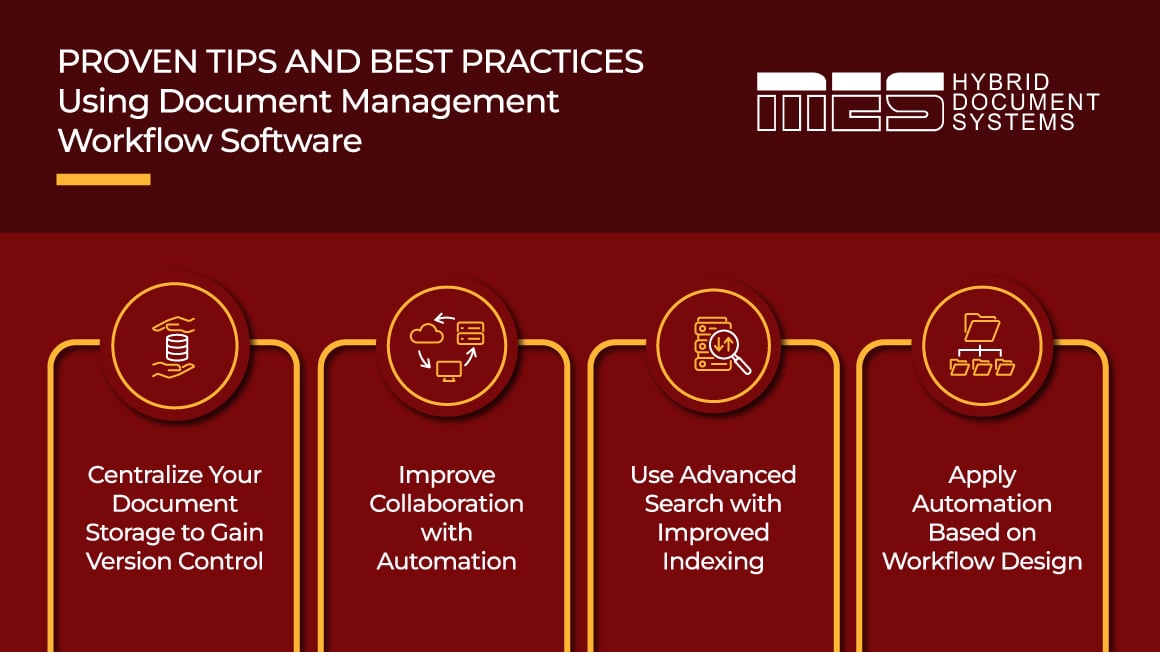Document management takes more time than the average small to mid-sized business knows. In the average small business scenario, 100 paper documents are stored daily, taking three to five minutes per document. A small business with 10 employees will retrieve an average of 20 documents per day, taking an additional five minutes per document. Each employee also spends an average of 30 minutes per day dealing with manual document prep and routing.
Each month, this time can reach up to 360 hours or so of manual document management. Therefore, optimizing document management workflows can save you 360 hours of labour put to better use focusing on core business functions. Here we share proven tips and best practices using document management workflow software to achieve maximum efficiency.

Centralize Your Document Storage to Gain Version Control
Effective document management workflow uses a centralized document storage system. This system is the hub for your workflow, ensuring everyone across your enterprise is working from the same document version. You control the number of versions circulating in the office, eliminating random copies on people’s desks, missing files during your approval process, and unauthorized edits that might be applied to digital files emailed from person to person.
Everyone collaborates from one storage system, so there is no misunderstanding of the “latest” version of the information, as there is only one file that is always real-time current. You finally gain control of data, making collaboration a safe bet and streamlining group projects to ensure everyone is literally working from the same page.
If you’re worried about who sees what, you can introduce permission or role-based authorization so only those involved with the document or project have access. This also helps maintain accountability across the entire company.
Improve Collaboration with Automation
Automation increases productivity creating an efficient workflow and collaboration process. When teams work together using manual tasks and sharing paper documents and files, it not only takes time but also increases the risk of errors or missteps in your process. Automation streamlines document management and workflow allowing you to:
- Create automated approval streams so nothing moves forward without proper authorization
- Use task triggers that automate next steps – one task triggers a series of steps that are moved through your workflow from person to person, step by step
- Enable notification when actions are required so all team members know when an action is completed and they are now up to bat
- Tag team members who don’t typically get involved in specific processes for rare cases when they need to take action to keep workflows moving forward
- Use real-time status reports that keep everyone informed of where the projects stand with notifications that remind people if their tasks are holding up the process
- Automate recurring activities such as invoice approvals, accounts receivable reconciliation, payroll approvals, sign-offs for weekly reports, etc.
- Customize tasks specific to your business activities, such as sending out order confirmations, acknowledging payments are received, enabling sharing for specific outside stakeholders, etc.
Automation keeps your business scalable and flexible with streamlined processes that improve your document management system workflow and enhance collaboration with internal and external players.
Use Advanced Search with Improved Indexing
We’ve already shared the numbers on how much time your team is potentially wasting on things like searching and managing documents manually. Keeping that number in your head, imagine how easy life would be if you could use keywords to find documents instead. A document management workflow system allows you to introduce indexing into your document storage system. Data capture technology and scanning digitize paper documents and microfilm/fiche, storing all your information in the same easy-to-access format.
You then use indexing to categorize data using specific criteria, metadata, and keywords, creating advanced search capabilities. Search functionality optimizes document workflow taking search times from minutes to seconds. Your team can apply filters or keywords to search documents and instantly retrieve information.
You also never worry about lost or damaged documents. In fact, despite being a digital filing system, you don’t even have to worry about accidental deletion. We all know these things can happen, whether it’s a rogue cat paw on a work-from-home keyboard or clicking the wrong document during a records retention clearout. Document retrieval capabilities ensure you always have a backup to find deleted or archived documents instantly.
Apply Automation Based on Workflow Design
Workflow design maps out sequential tasks involved in your processes. Many of these tasks are manual. You can streamline workflow designs using document management workflow automation to help your team move from task to task effortlessly.
Remain Compliant
Automate record retention and create audit trails to improve compliance with government document management regulations, including:
- Document retention: Document management and workflow automation allows you to set criteria for record retention so the appropriate person is informed when records have reached their retention dates. You can also trigger automated record deletion protocols to avoid deleting a record too soon.
- Audit trails: Create document audit trails to prove compliance with industry regulations. For example, permission-based access ensures you can show who accessed files for documents mandated by privacy rules. You can also respond quickly to auditor requests with records showing document captures, versions, and annotations for complete transparency with auditors.
- Version control: As mentioned, you maintain version control so your records remain current, an essential detail for healthcare, HR, educational, CASs, and financial records.
- Company policy compliance: A document management system produces reports that confirm using an organization’s standard operating procedures to improve accountability across your entire company.
As you can see, it just takes a document management system to optimize workflow in your organization. You can maximize the value of your document management systems using these best practices and reap the benefits of efficiency, productivity, and cost savings.
If you want to maximize the value of your document management, speak to an MES expert. We can demonstrate how document management software leverages automation and streamlines your processes. Click here to set up a free consultation today.

